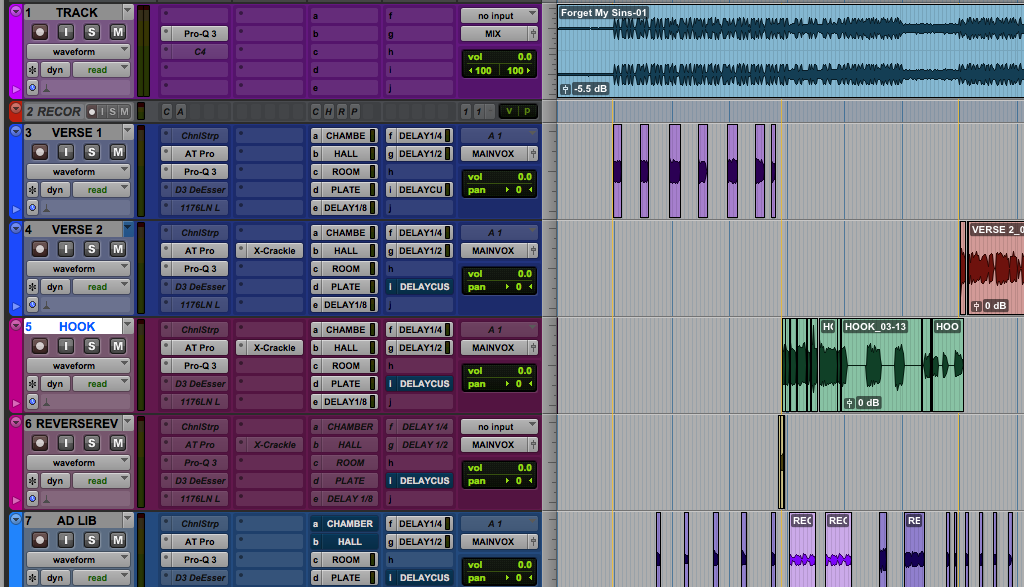Mixing vocals to a 2-track instrumental is something every engineer will encounter at some point. It’s especially common in hip hop/pop, where artists routinely download pre-mixed instrumentals online and bring them to a studio to record. The challenge with learning how to mix to a 2-track beat is getting the vocals to sit in a space that feels right. The following are some tips and ideas to consider when approaching a mix like this.
Handling the Beat
Without fail, a pre-mixed beat has been compressed and limited for loudness. Many hip-hop producers are mixing their instrumentals specifically with loudness in mind. This makes it tricky to try to squeeze some brand new vocal information into a seemingly complete arrangement.
So, the very first thing you’ll want to do is pull the 2-track’s level down to give yourself some headroom. If you don’t you’ll be hitting 0 just because you’re playing the instrumental back. I usually find 6 dB to be enough, but there are some particularly loud beats that have required more.
Get Your Vocals Right First
The first thing you should do is get the vocals sounding solid.
If you have a lot of clients bringing you instrumentals to track over, creating a vocal mixing template is the best way to go. It’ll drastically expedite the mixing process if you already have your vocal chain(s), reverb/delay sends, and other processing ready to go. It’s helpful for tracking, too, when an artist might want to record through Auto-Tune, with some reverb/delay, or anything else they might request.
Overall, your vocals should compliment the instrumental, so keep this in mind while you’re mixing them. Here’re some tips:
Vocal Compression
The most common problem you’ll run into when mixing vocals to a 2-track is that they’ll feel lost under the beat itself, or they’ll hover awkwardly above it. Most of this has to do with the fact that the beat is already heavily processed, and now we’re trying to add a ton of new information on top.
Most of the time we have no other choice than to let those vocals sit sort of on top of everything, lest they be totally overpowered. We can try to minimize that sensation, but it’s hard to completely avoid. One thing you can do to get them to mesh better with the 2-track is by compressing in small increments with the intent of creating a similar compressed feel that the instrumental already has.
We talk about this a lot, but you’ll want to avoid letting one compressor do all the work. If you do, you’ll hear it working way too hard — it won’t sound good. Instead, use a few compressors all doing a conservative amount of gain reduction.
Figuring out what works for you is all part of learning how to mix, but an 1176 into an LA-2A is a famous vocal chain worth trying! Then you can play around with various amounts of gain reduction to get the results you’re after.
Tonality
Pay close attention to the overall timbre of the instrumental. Is it bright? Dark? Mid-rangey? This will give you some insight in how to start processing your vocals. You’ll want them to ‘match’ to a certain extent, again so that the vocals appear cohesive with the beat. A lot of this can be done with EQ and shaping the vocal frequency content.
Processing the Instrumental
When you’re confident in your vocal sound for the given instrumental, you may need to work on the 2-track up a bit to give them a bit more space.
EQ
Try not to overdo it if you decide to EQ the pre-mixed beat. You’ll typically want to avoid broad Qs and heavy cuts unless you want to totally change the quality of the instrumental; probably not a great idea. Sometimes just a gentle high-pass filter around 20 Hz can remove some of the sub frequencies that eat up a huge amount of mix space, buying you a bit more headroom.
If you can hear a specific frequency in the beat that really isn’t gelling with the vocals, try to notch it out. One problem I hear a lot are really harsh hi-hats that feel like an ice pick in the ear! I’ve been a little reckless at times and pulled down broad swaths of high-end info in those cases.
But again, be gentle if you can. You have to remember that your artist specifically chose this instrumental because they like it. They’ve probably written and rehearsed to it a hundred times, and it sounds a certain way to them. We don’t want to completely change the relationship they have with the beat by making it unrecognizable to them.
Mid-Side Processing
This is actually incredibly handy. With M-S processing, you can separate the information in the center from the stuff on the sides. So if you bring the center down a tad, you’re just making space for vocals.
